Sandy Beach Processes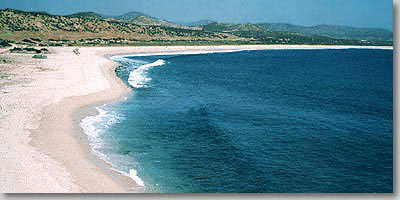 | The sandy beach is one of the most rigorous habitats for organisms on Earth. The main reason is that the constantly shifting sand lacks any type of stability. This sand movement is caused by the waves that constantly break along coasts. Every wave shifts the sand and changes in the size of the waves and the direction of the waves increases or decreases the intensity of this sand movement. (Image, with permission, from Western Marine Lab) |
There is a large community of organisms inhabiting most sandy beaches, however the number of species represented is limited. The shifting sands and rapidly changing conditions makes it difficult to live in this habitat. Only a few species have been successful. Those that have successfully adapted to this habitat, enjoy lower levels of competition and can grow to larger populations. |
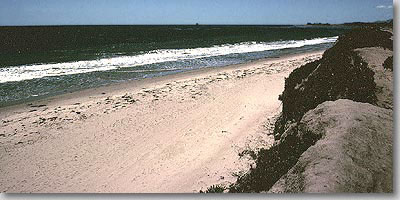 | Waves move sand each time they break along a sandy beach. Large waves tend to remove sand from a beach whereas small waves tend to deposit sand on a beach. The energy of the wave determines what size sand particles will be picked up and how far they will be moved. A steady stream of large waves over a period of days or weeks may actually remove all the sand from a beach, leaving only boulders and/or bedrock. On the contrary, a steady stream of small waves may deposit so much sand on a beach that it increases the width of the beach many times. (Image, with permission, from Western Marine Lab) |
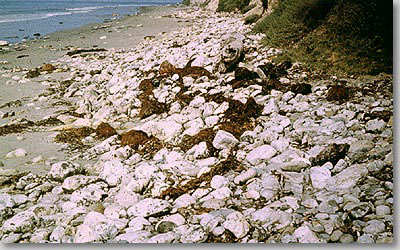 | Large winter waves take away sand from a sandy beach. Although each year is different, a winter beach generally has much of the fine sand removed. In years with a succession of large waves during periods of high tides many of the beaches almost disappear. This picture shows a beach that has had a period of big waves that have removed most of the fine sand, leaving only rocks. (Image, with permission, from Western Marine Lab) |
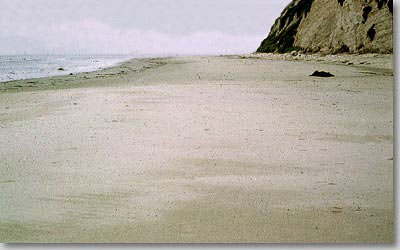 | Small summer waves pile sand up on the beach. This picture is of the same beach shown in the previous picture but after a period of small waves for several months. This is the typical "summer beach" piled high with fine sand. Under all the sand is the layer of rocks you saw in the previous picture. (Image, with permission, from Western Marine Lab) |
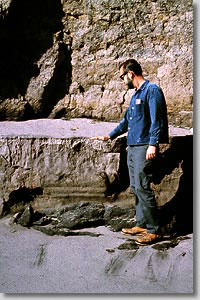 | One high tide with large waves can change the beach. This picture shows the effect of big waves during one high tide. The summer beach level was gouged out by the big waves leaving bedrock exposed. After a few tidal cycles this drop in the beach will not be so pronounced as waves and wind smooth out the beach. The general area just above where the most recent high tide has reached is called the berm crest. The waves rarely spill over the berm crest. Here, the berm crest is a sharp drop. (Image, with permission, from Western Marine Lab)
Summer Winter Beach Regime is the name given to the yearly changes in beaches due to different wave heights. It is common in all areas on earth that experience any seasonal changes in the height of the waves. |
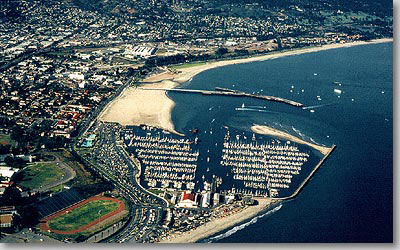 | Sand is moved along the shore by the direction the waves are traveling, as well as onshore and offshore by changes in wave height (summer winter beach regime). Most waves reach a coastline from either an upcoast or downcoast direction. Rarely do waves come directly straight in (although they may appear to), waves bend as they enter shallow water and break in a more or less parallel direction to the shoreline. Each wave usually breaks starting from either a downcoast or upcoast direction. (Image, with permission, from Western Marine Lab) |
The angle of the breaking waves creates a movement of sand along the shoreline, within the surf zone, and in the direction the waves are traveling. This movement of sand parallel to the shoreline due to the angle of the breaking waves is called longshore transport.
Along most of the coastlines of the United States the net longshore transport is from north to south (downcoast). This is due to the fact that the majority of the waves that hit the coastlines of the United States come from the Arctic area. Here in Santa Barbara the longshore transport is downcoast about 80 percent of the year. There are a few tropical storms that create an upcoast longshore transport but these are generally less than 20 percent of the time.
This aerial photograph of the Santa Barbara harbor shows the sandspit at the downcoast end of the breakwater. The sandspit forms from the net downcoast longshore transport of sand. The end of the sandspit must be dredged every year to prevent the mouth of the harbor from closing as the sand accumulates. |
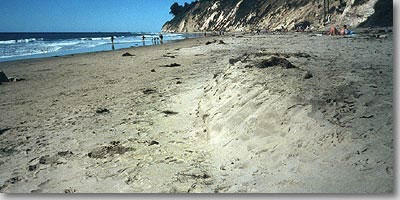 | The berm crest is the break between a predominantly terrestrial and a predominantly marine habitat – it is the area of the highest high tide waves. The beach behind the berm crest, or landward, is called the backshore and is where the sand is dry, rarely exposed to any ocean water. Organisms found in the backshore area are generally terrestrial forms from nearby. (Image, with permission, from Western Marine Lab) |
The backshore may be composed of sand in many sizes, colors and shapes. The sand grains can be large or small - the larger ones make the beach less hospitable for life forms (because they crush the critters while they shift). The color of the sandy beach also affects the hospitality of the beach - the darker sediments tend to get very hot in the tropics at low tide. Finally, the shape of the sand is also important for the hospitality of the sandy beach - sharp-edged sand grains tend to cut organisms. It is the sandy beaches with small, light-colored, rounded sand grains that tend to have the most marine life. The gravel-like, black sand beaches in Hawaii that are newly formed by exploding lava (on the south side of the big island of Hawaii) have sharp edges (like points of glass) and few life forms (if at all). |
From the berm crest to the ocean the beach is known as the foreshore. This foreshore area is the habitat known as the marine sandy beach and is inhabited by specialized marine species. |
|

